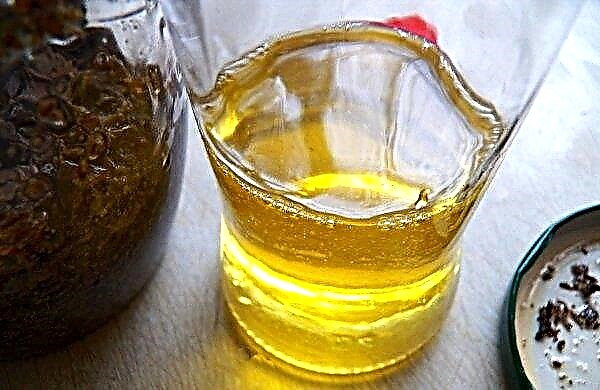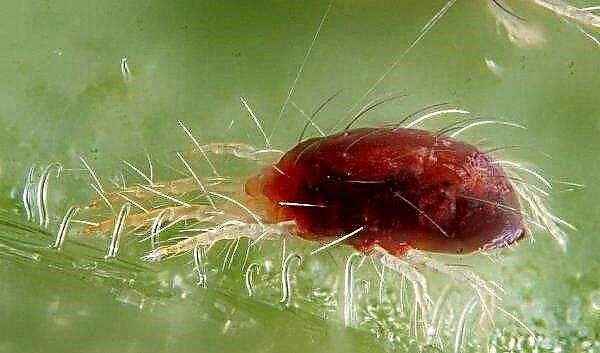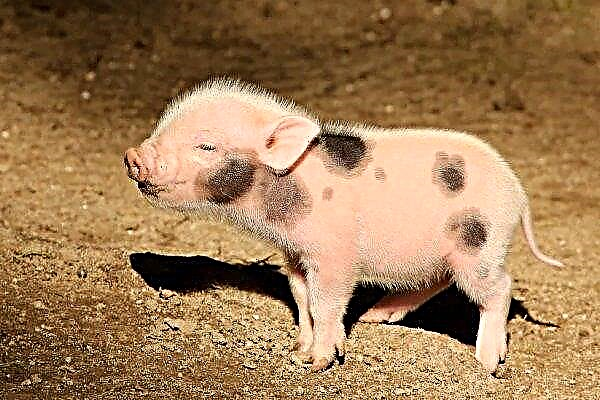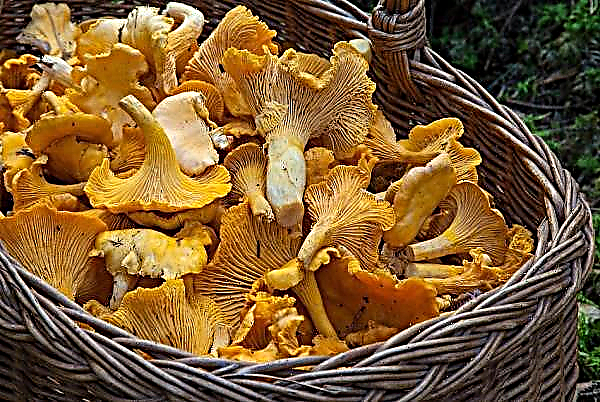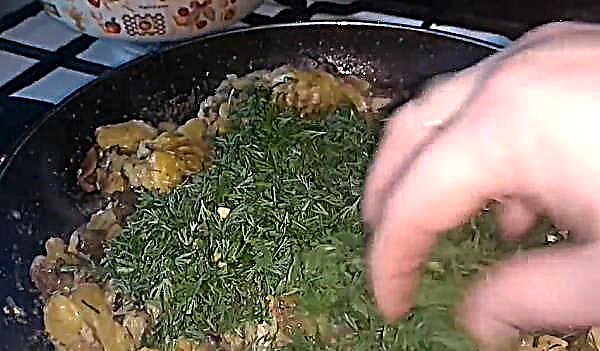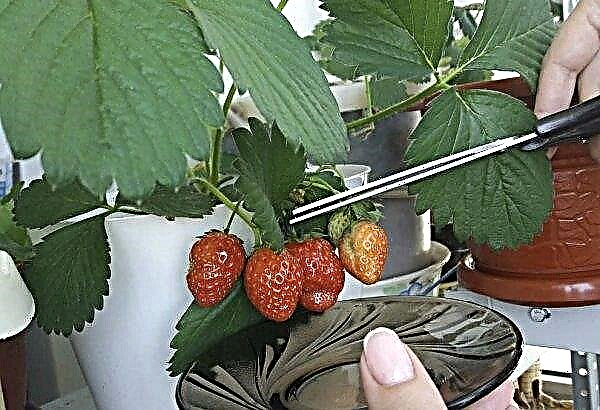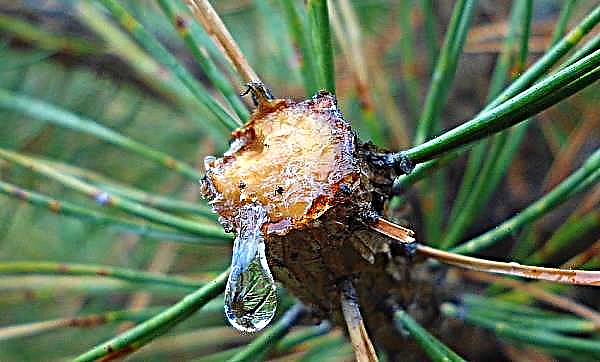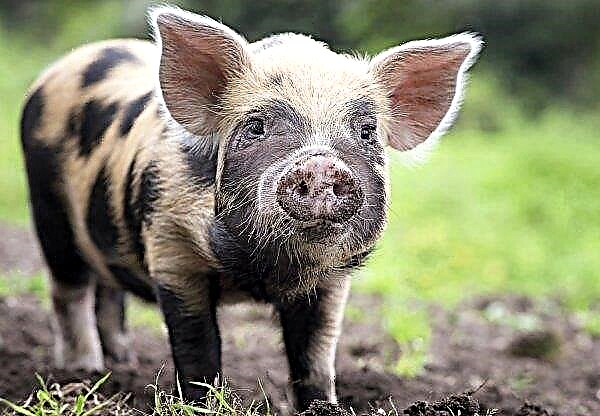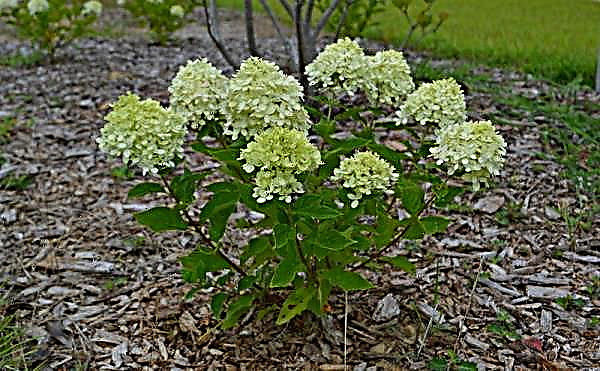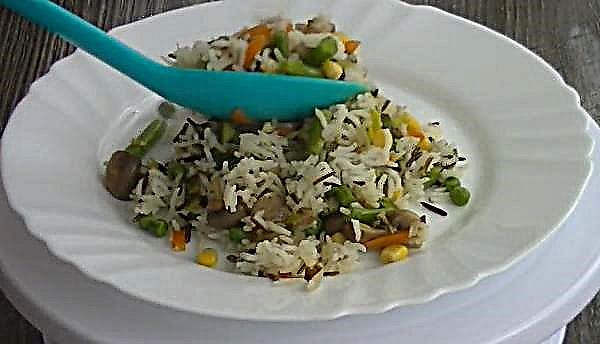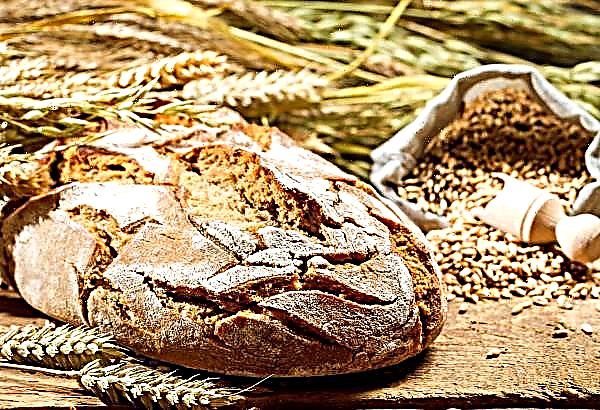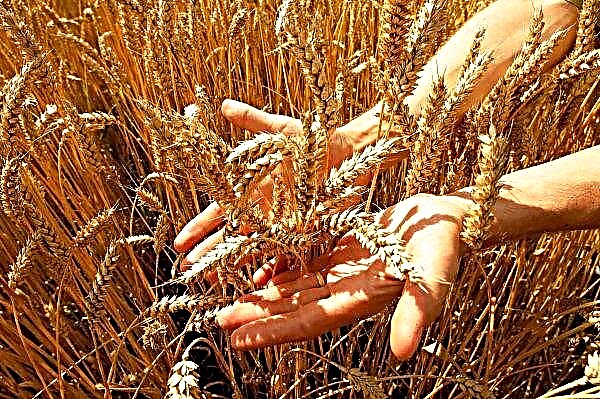Potatoes, simply called "red-eyed", are willingly grown by land owners. We learn about the Aurora potato variety, its pros and cons, and the agricultural technology of its cultivation.
Selection history
Aurora potato variety was obtained at CJSC Vsevolzhskaya Breeding Station in the city of Kirovsk (Russia). It was the result of the work of a group of breeders - T. Kolesova, E. V. Bryantseva, G. N. Slobodina, O. I. Zueva and V. E. Zueva
He was included in the State Register of the Russian Federation in 2006. Recommended in many regions of Russia due to its unpretentiousness - from the North to the Caucasus.
Did you know? In the world there are more than 5 thousand varieties of potatoes. Of these, more than 400 are recorded in the State Register of Russia.
Characteristic and Description
This is a medium term variety. Root crops begin to dig no earlier than 70 days from the appearance of seedlings. It forms powerful shrubs with high, well-leafy tops and large light green foliage. Blooms with flowers in violet tones.
On average, yields 250-300 kg / ha, but under good conditions, yields can reach 416 kg / ha. From one bush of Aurora potatoes 15–20 root crops of elongated shape and smooth pinkish-brown peel are harvested. The eyes have a reddish skin color. The eyes themselves are not particularly prominent, small.
Photo gallery
The tubers have a creamy flesh with excellent taste and a starch content of 14-17%. From it you can cook different dishes. The yield of marketable tubers is 89–93%, and their shelf life reaches 94%. It is not at all affected by the golden potato nematode and potato cancer, and is moderately resistant to late blight.Advantages and disadvantages of culture
- Aurora potato variety has many advantages:
- high yielding capacity;
- excellent taste of root vegetables and the versatility of their use;
- presentation of tubers;
- ability to be well stored;
- disease resistance;
- unpretentiousness.
- The following conditionally can be considered its disadvantage:
- not particularly suitable for an early harvest;
- the need for more frequent hilling due to the presence of tall tops.
Did you know? Fresh potatoes are good for stomach ailments. Potato juice can be treated for heartburn, gastrointestinal ulcers and gastritis with high acidity. It improves digestion and stimulates intestinal motility.
Optimal landing times
Planting dates depend on the climate of the region and the weather. Aurora potatoes should be planted when the soil has warmed up to + 8 ° C and the threat of return frosts has gone. Doesn't bother to listen to the weather forecast. In the southern and temperate regions, this weather is already set in April, and in the northern regions - in the first decade of May. During this period, the appearance of the first leaves of the birch can be observed. Landing dates can stretch until June. Potatoes are often planted after harvesting early radishes. However, one cannot drastically delay the planting of this crop - a lack of moisture will not allow to form a good crop. Most often, the landing of this culture is carried out on May holidays.
Potatoes are often planted after harvesting early radishes. However, one cannot drastically delay the planting of this crop - a lack of moisture will not allow to form a good crop. Most often, the landing of this culture is carried out on May holidays.
In the southern regions, two crops can be harvested from this variety.
Planting and growing potatoes
To get the maximum yield, you should properly prepare and plant the nodules.
Crop rotation rules
In order to grow a good crop and avoid the appearance of certain diseases, as well as pests, you need to follow the rules of potato crop rotation. Good predecessors of such root crops are winter bread, legumes (peas, beans, lentils, beans), herbs, onions, garlic and gourds. Do not plant potatoes, where it used to grow even after solanaceous crops (tomato, pepper, eggplant, physalis) - they are affected by the same diseases as potatoes. Bad predecessors will also be cabbage, pumpkin, clover, since such plant crops contribute to the appearance of black scab. Planting potatoes in the area where potatoes were previously planted is not worth 2-3 years. If the plot is very small and there is no opportunity to change crops, then varieties should be changed and sown after failure of the green manure.
Planting potatoes in the area where potatoes were previously planted is not worth 2-3 years. If the plot is very small and there is no opportunity to change crops, then varieties should be changed and sown after failure of the green manure.
Soil requirements
Potato prefers nutritious, slightly acidic soils. Land for planting begin to prepare in the fall. The soil is fertilized with organic matter (4-5 buckets of mullein per 10 m²) and superphosphate at the rate of 1 cup per 10 m². Then you need to dig the earth for the winter. If fertilizers were not applied in the fall, then when planting fertilizers are applied directly to the wells. At the same time, a handful of humus, a little superphosphate or nitroammophoski is placed in each well.
Important! In spring, fresh manure cannot be used as fertilizer, since an excess of nitrogen in it will reduce the quality of the crop.
Preparing planting material
For planting, absolutely healthy and undamaged tubers are chosen. To protect potato tubers from diseases and pests, appropriate treatment is used. To carry out such processing used drugs "Prestige", "Matador", "Maxim". Gardeners for the treatment of tubers like to use potassium permanganate (5 g per 5 l) or boric acid (6 g per 10 l). Processing with an ash solution (1 kg per 10 l) or sprinkling nodules before planting ash powder is very popular. Potatoes should be sprouted before planting. To do this, a month before planting, the planting tubers are placed in low boxes in 1-2 layers and transferred to a warm place, which is well lit by sunlight. Under the influence of sunlight, tubers sprout. Large tubers can be cut in half, and sprinkled with ash to cut the place. The first 10 days for germination set the temperature +18 ... + 20 ° C, and then reduced to +8 ... + 15 ° C. This will allow the sprouts not to stretch, but to be strong and then give friendly shoots.
Potatoes should be sprouted before planting. To do this, a month before planting, the planting tubers are placed in low boxes in 1-2 layers and transferred to a warm place, which is well lit by sunlight. Under the influence of sunlight, tubers sprout. Large tubers can be cut in half, and sprinkled with ash to cut the place. The first 10 days for germination set the temperature +18 ... + 20 ° C, and then reduced to +8 ... + 15 ° C. This will allow the sprouts not to stretch, but to be strong and then give friendly shoots.
Landing technology
Potatoes are planted in spring at an air temperature of at least + 10 ° C. The optimum temperature for planting in the ground is +15 ... + 18 ° C. So that tall bushes do not obscure each other, the gap between the rows is 0.6–0.8 m. Root crops are carefully laid out in the prepared pits with sprouts up. Then sprinkle with soil 10-15 cm.
Potato care after planting
After the first sprouts of Aurora potatoes appear, it is necessary to organize proper care, which will increase the crop yield. First of all, it is hilling and loosening the soil, watering, and feeding.
Hilling and loosening the soil
After the emergence of sprouts, it is necessary to carry out the process of hilling. In small summer cottages, each bush is spudded with a hoe from all sides. If the sprouts accidentally fall asleep in the soil, do not worry, so they will not stop their growth. The ground for such work should be moist. It is best to carry them out after rain or watering. The second time they carry out hilling when the bush reaches about 18–20 cm above ground level. Periodically after rains, it is recommended to loosen the soil and remove weeds.
It is best to carry them out after rain or watering. The second time they carry out hilling when the bush reaches about 18–20 cm above ground level. Periodically after rains, it is recommended to loosen the soil and remove weeds.
Important! It is necessary to carry out the earthing up of Aurora potatoes in order to prevent the tops from falling to the ground. This can cause a rotting process in the crop.
Watering and fertilizing
Regular watering begins to be carried out only a week after the emergence of seedlings, as in planting root crops there is enough moisture and nutrients for the formation of sprouts. Excess moisture at this time will be harmful to the growth and development of the plant. Subsequently, the bushes are abundantly watered about once every 7 days. The volume of fluid under each bush is about 2-3 liters. During the flowering period and the formation of root crops, it is necessary to increase watering to 3-5 liters. Organic fertilizers (manure, bird droppings) and mineral fertilizers such as nitrate, nitroammophoska, urea, and kalimagnesia are used for top dressing.
Organic fertilizers (manure, bird droppings) and mineral fertilizers such as nitrate, nitroammophoska, urea, and kalimagnesia are used for top dressing.
Rotted manure can be done independently. To do this, fill any large container (preferably a barrel) with manure or chicken droppings by 50% and add water. After 3-4 days, rotted manure is ready. It can be stored throughout the summer period.
Gardeners recommend feeding at least three times:
- When sprouts appear, the first fertilizer is applied. Such dressing can be made independently as follows - in a bucket of 10 l dilute 0.5 l of rotted manure or bird droppings, 15 g of urea. Under each plant you need 0.5 liters.
- During flowering, such dressing is prepared - 15 g of potassium sulfate, 15 g of superphosphate double, 50% of a glass of wood ash are taken per 10 liter bucket of water. About 0.5 l is consumed per plant.
- During the period of active formation of tubers, but always 20 days before the collection of root crops, carry out the last top dressing. To do this, 30 g of simple superphosphate, a glass of rotted manure (bird droppings) are stirred in a 10 liter bucket of water. Under 1 bush is 0.5 liters.
Important! After the potatoes have waned, potash fertilizers should be increased for top dressing and nitrogen-containing top dressings should be reduced. Excess nitrogen will negatively affect the crop.
Pest and Disease Control
The Aurora potato variety is quite resistant to a number of diseases, but with violations of agricultural technology or care, as well as adverse weather conditions, the following problems may arise:
- brown rot;
- blackleg;
- scab;
- alternariosis;
- peronosporosis;
- mosaic;
- necrosis.
 From the black leg, root crops should be treated with “Prestige”, “Maxim” preparations. From viral diseases, including mosaic and necrosis, preventive spraying with fermented milk serum helps.
From the black leg, root crops should be treated with “Prestige”, “Maxim” preparations. From viral diseases, including mosaic and necrosis, preventive spraying with fermented milk serum helps.Potatoes may be susceptible to invasion by the following pests:
- Colorado beetle. The most common pest of this plant crop. To combat it, you need to destroy beetles and larvae in a manual way, and you can use spraying with chemicals like "Confidor". Spraying should be stopped 20 days before the collection of root crops.

- Wireworm. From such an insect, tubers are treated immediately before planting with the Prestige preparation.

- Bear To prevent the occurrence and control of such a pest, the chemical agent Medvetox is used. Granules of this substance must be put in the holes and sprinkled over the site during planting, and then in the summer when the pest is detected.

Harvest Dates
3 months after planting tubers of the Aurora variety, you can dig potatoes. With proper care, about 3 kg can be obtained from each bush. Young potatoes are obtained after 2 months.
The tops will be ready for harvesting, the tops will say - it will completely dry out, and the potatoes will freely separate from the root lobe. During heavy rains, dug root crops from wet soil are washed with water from a hose and allowed to dry.
Before moving to a place to store root crops, you need to sort out. Damaged specimens are rejected, and normal ones are sorted for planting material and for eating. Optimum temperature conditions for storage from + 2 ... + 5 ° C. It is better to store in boxes made of wood or plastic.
Potatoes Aurora gives abundant harvests with proper care. Its tubers look marketable, have excellent taste and are well stored.Did you know? The Belgians have a museum dedicated to the culture of potatoes. Among his exhibits is Van Gogh's famous painting, “The Potato Eaters.”




